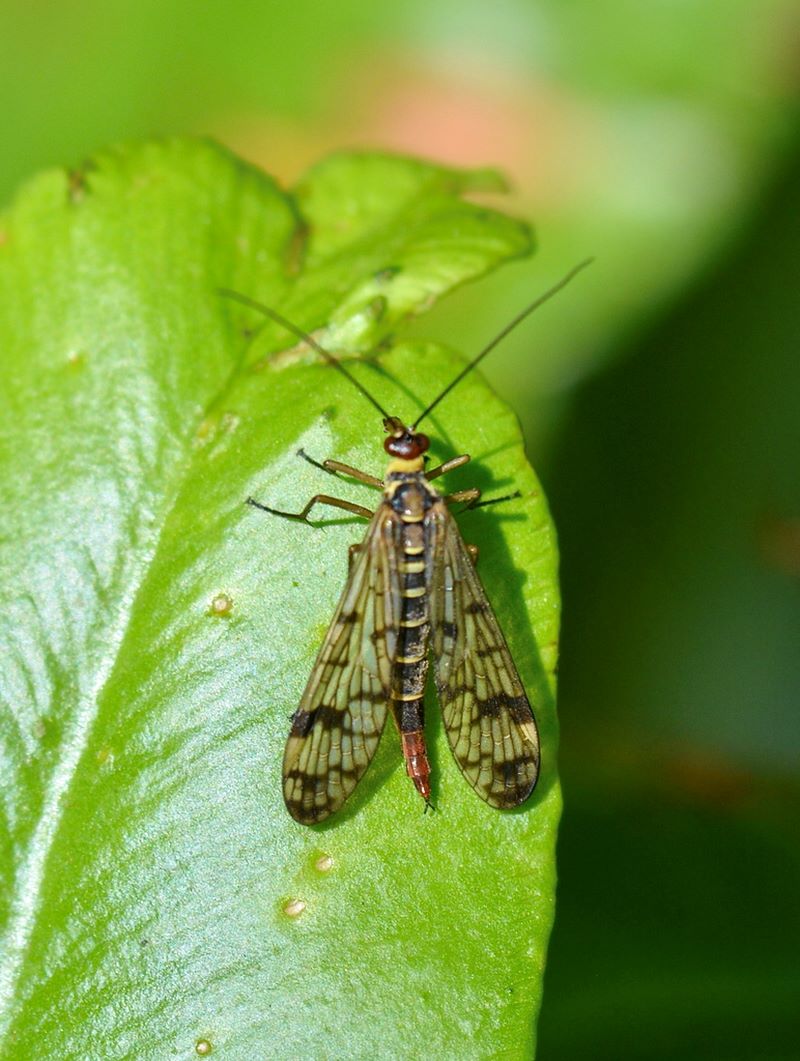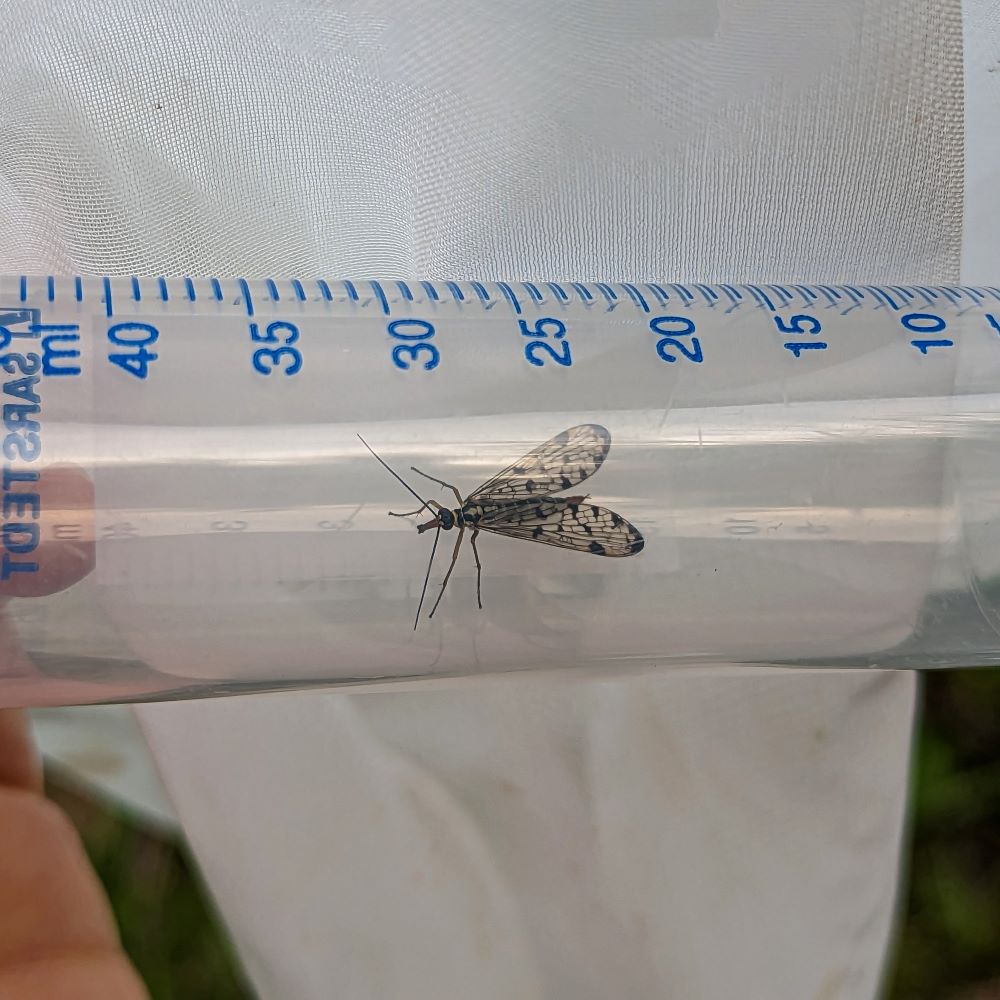December 5, 2023
On the Hunt
ISTA scientists unravel mysteries of “one of the creepiest-looking” insects
In spring, Jackson W. Ryan—the first Journalist in Residence at the Institute of Science and Technology Austria (ISTA)—set out to go looking for scorpion flies on Campus with postdoc Clementine Lasne from the Vicoso group. Now, the research group has successfully deciphered the black and yellow-striped insect’s full genome, shedding new light on the evolution of their sex chromosomes. Their findings are published in the journal Molecular Biology and Evolution.
A report by Jackson W. Ryan.

At the end of April 2023, spring was desperately trying to break through the gloom in Vienna. The sun would peek through the clouds for a day or two but then disappear for a week. Though I herald from Australia—where spring is basically summer with a slight breeze—I’m prone to sunburn and quite enjoy the rainy, overcast days. But for a week, I’d been hoping to see the sun. I wanted to go hunting.
Clementine Lasne, an evolutionary biologist at ISTA, had invited me to stalk an insect that has been dubbed “one of the creepiest looking” on the planet. Under grey skies, it would likely remain hidden. If the sun finally reappeared, it would emerge, settling on leaves just a few meters beyond ISTA’s borders.
When the sun finally did appear, we got our chance. The hunt was on. We were going to search for scorpionflies.
By name alone, they sound like mythological beasts similar to the gryphon, that legendary creature with the head of an eagle, the body of a lion and a snake for a tail. I didn’t know what to expect. Would a scorpionfly look something like that? A chimaera of two different insects (or more?) stuck together? I refused to Google it before we took off. I didn’t want to spoil things; I wanted to be surprised.
I meet Lasne after lunch on a Monday afternoon in early May. She’s carrying her net and sample tubes. We take off toward the forest behind ISTA, walking along the backroads, past the kindergarten and onto a gravel path. As we stroll, she picks out all sorts of insects and arachnids—a parasitic wasp, bumblebees and spiders—while scanning for our target.
“They love nettles,” she explains, suggesting I can probably find the insects just “hanging out” on top of a leaf at the side of the road—if my shadow doesn’t scare them away first. Within minutes, we’d stop. “I think there’s one,” she points out. “I’ll try to get it.”
Armed with nothing but her big insect net, she moves slowly and then…
WHACK.
The technique for catching a scorpionfly is all about speed. Her net flies over the nettles so quickly it surprises me. Lasne begins to inspect the catch. “I got it,” she says, looking into the bag, now full of an array of bugs I didn’t even know were in the grass a second ago. She puts the scorpionfly into a transparent sample tube, so I can take a look.
She confirms it’s of the species Panorpa germanica or “the German scorpionfly” by studying the wing pattern. She can also see it was male—exactly what we wanted. Only the males bear the characteristic “tail” that gives the scorpionfly its name. The critter remains fairly docile and, as Lasne slowly rotates the tube, I get the first glimpse of the scorpionfly’s rear appendage.
It certainly looks like a fly with a scorpion’s tail, a characteristic bulged stinger resting at its back. But it’s not a tail and it doesn’t sting. The appendage is what’s known as a cercus. For male scorpionflies, it acts as a copulatory organ. Basically, it’s for mating.
“We’re not exactly sure why it’s taken this shape,” Lasne says. Lasne and her colleagues in the Vicoso group at ISTA are not particularly interested in the mystery of the scorpion-like genitals or exploring scorpionfly mating practices, as interesting as they may be. The mysteries they’re trying to unravel are contained within the sex chromosomes.

Let’s talk about sex chromosomes
Most mammals, including humans, have 23 pairs of chromosomes—bundles of genetic material that contain essential genes for a variety of functions. One of those pairs is composed of the sex chromosomes, which come in two forms denoted as an X or a Y because of how they look when viewed down a microscope. Females have two X chromosomes (XX) and males an X and a Y (XY). A female always passes down an X, but a male can pass down an X or a Y, determining the sex of the progeny.
Scorpionflies are different. Previous research on Chinese scorpionflies has shown that, like many insects, the females are XX, but their males are XO or “X-nothing.” The males get one X chromosome, while the “O” is not a chromosome at all. It’s the lack of one. That means females pass down an X and males either pass down an X or nothing at all.
Scorpionflies belong to an order of insects known as Mecoptera, a sister order to that typically referred to as “true flies”, “Diptera”. Dipteran chromosomes are another beast altogether. They have anywhere between 6 and 11 chromosomes, and some are referred to as Muller Elements A through F, after the biologist who discovered them. Lasne notes that Dipterans are odd and they play “musical chairs” with their sex chromosomes a lot, so some species have a sex chromosome with Element A, others B and so on. All these switches make it difficult for evolutionary biologists to trace the history of the X chromosome.
One particular element, F, is a tightly bundled chromosome that looks like a dot under the microscope (and for that reason has been referred to as the dot chromosome). This chromosome may have been the ancestral sex chromosome for dipterans, but it has been replaced by another chromosome nowadays. Studying mecopterans like Panorpa could help reveal the history of this sex chromosome across insects.
Decoding a scorpionfly genome
In their latest study, conducted by the Vicoso group at ISTA, the team produced the first full genome sequence for Panorpa cognata providing a way to begin answering that question.
To do this, the lab collected scorpionflies specimens in August 2021, near the spot Lasne and I went hunting in May 2023. During their expeditions in the summer, they nabbed dozens of specimens of scorpionfly, from all three species that call the ISTA campus in Maria Gugging home. The most abundant, they found, was Panorpa cognata.
They extracted DNA from one male and one female to reconstruct the genome and assessed the total RNA in heads, gonads and carcasses from three samples of both sexes. In a nutshell, the team was basically trying to put all the DNA puzzle pieces together, reconstructing a full picture of the X chromosome and characterising some of its features. First, they discovered that, like Chinese scorpionflies, Panorpa cognata uses the XX/XO system.
They also found the X is structured similarly to the X chromosome of cockroaches and locusts, as well as the Muller Element F. Under a microscope, the scorpionfly X forms a dot – just like Element F. Could Muller Element F and the scorpionfly X chromosome share ancestry?
“The fact we found that the scorpionfly X chromosome is very similar to the Muller element F of Diptera points in this direction,” Lasne says.
The find hasn’t yet helped answer the question about why Dipteran X chromosomes seem to be playing musical chairs while other insects show conservation of their X over millions of years. Other puzzles have appeared, too. The X chromosome in scorpionflies seems to contain a lot of male genes, even though it spends twice as much time in females. It’s unclear why this would be the case, as some scientists have hypothesized that we’d likely see male genes flee from the sex chromosome, their functions replaced by other chromosomes.
“There are still lots of mysteries about insect sex chromosome evolution,” says Lasne. Which means, net in hand, she’ll be heading out to collect more scorpionflies with the first warming rays of sunshine.
Publication:
C. Lasne & M. Elkrewi, M. A. Toups, L. Layana, A. Macon, B. Vicoso. 2023. The scorpionfly (Panorpa cognata) genome highlights conserved and derived features of the peculiar dipteran X chromosome. MBE. DOI: 10.1093/molbev/msad245
Funding information:
This research was supported by grants from the Austrian Science Foundation to C. Lasne (FWF ESP 39) and to B. Vicoso (FWF SFB F88-10).
Information on animal studies:
In order to better understand fundamental processes, for example, in the fields of neuroscience, immunology, or genetics, the use of animals in research is indispensable. No other methods, such as in silico models, can serve as an alternative. The animals are raised, kept, and treated according to the strict regulations of Austrian law. All animal procedures are approved by the Federal Ministry of Education, Science and Research.



